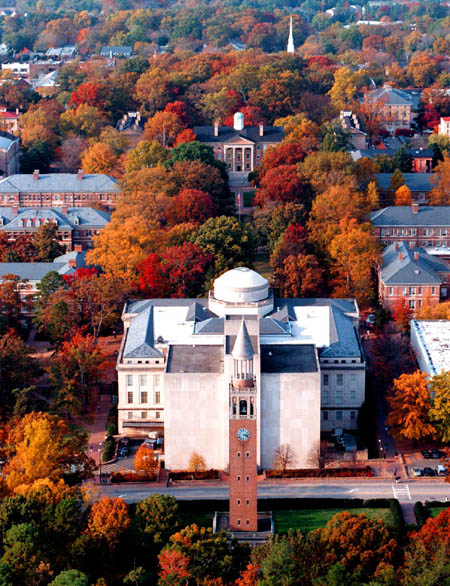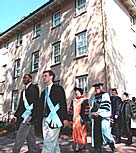





 |
"The thing That I have always admired about the University of North Carolina is its been a place that emphasized both academics and athletics and other extracurricular activities. And it's demonstrated to the country that it is not necessary to make a choice, and that there's something to be said for learning how to compete, to work on a team, to put aside your own personal ambition for what is best for a group, and that an institution like the University of North Carolina can really set a standard for the the entire country." - PRESIDENT WILLIAM JEFFERSON CLINTON
 |
 |
 |
 |
Some 23,592 students come from all 100 North Carolina counties, the other 49 states and more than 100 other countries to study. Nearly 69 percent of incoming freshmen graduated in the top 10th of their high school classes. More than 30 percent of incoming freshmen scored 1,300 or higher on their SATs. More than 57 percent scored of 1,200 or above.
Sixty-two percent of the 3,208 freshmen who enrolled in 1992 graduated after 4 years, a rate significantly higher than the 35-percent average among colleges in the Association of American University.
Ten Carolina students have been selected as Rhodes Scholars since 1980. Ninety-three percent of Carolina's 1996 graduating seniors said they were satisfied with the quality of the education they recieved at Chapel Hill, with 43.5 percent saying they were very satisfied. More than 210,224 living alumni reside in all 50 states and 129 foreign countries.
Carolina's full-time faculty of 2,417 includes professors who hold or have held major positions in virtually every national scholarly or professional association. Overall, more than 90 percent of Carolina's faculty members have earned their field's highest degree. Carolina's average student- teacher ratio is 14 to 1. A fall of 1992 study found that only 5.4 percent of 2,083 undergraduate class sections contained 100 or more students; 7,8 percent contained 50-99 students. Estimated average enrollment is 40 for freshmen lecture classes, 30 for upper division lecture course. Carolina boasts more endowed chairs held by black faculty members than any other university in the country.
 |
Carolina ranks among the nation's top 20 research universities in the amount of total federal support for research. Each dollor invested in Carolina creates an estimate $4 in net earings. That's a four-to-one return, and it means that sponsored programs at UNC contribute about $1 billion and some 15,000 jobs to the state 's economy. UNC contributes skilled employees to the North Carolina economy: 60 percent of the dentist, 40 percent of the attorneys, 43 percent of the physicians, 15 percent of the city manages and more than 10 percent of the college and university professors.
 |
In the U.S. News & World Report magazine's "America's Best Colleges" issue: Carolina was third among public universities and tied for 25th among all public and private universities. In Kaplan/Newsweek magazines's "How to Get into College" guide: Carolia was one of just 12 U.S. campuses called "first-rate schools at bargain prices." Editors cited some of the university's "pluses" as strong academics, high-quality facilities, a college-friendly town, a beautiful campus and powerhouse sports. According to Money magazine's "Your Best College Buys Now" guide: Carolina was the sixth-best buy based on out-of-state tuition for a second consecutive year and the second-best value in the southeast. Carolina was the top-scoring public university in the country for academic quality and financial value in the March 1997 issue of Kiplinger's Personal Finance Magazine.
 |
Among 40 members of the American Association of Universities, Carolina ranked second in 1995-96 in the per- centage of bachelor's degrees awarde to women (60.4 percent) and fourth in percentage awarder to blacks (8.9 percent). The University's $440 million Bicentennial Campaign for Carolina held from 1989 through 1995, was the largest fund-raising campaign in the university's history and the fourth-largest campaign ever completed at public university. In 2000 the voters of the state of North Carolina passed a $3 billion dollar higher education bond. Of the $3 billion, $500 million will be come to The University of North Carolina at Chapel Hill.